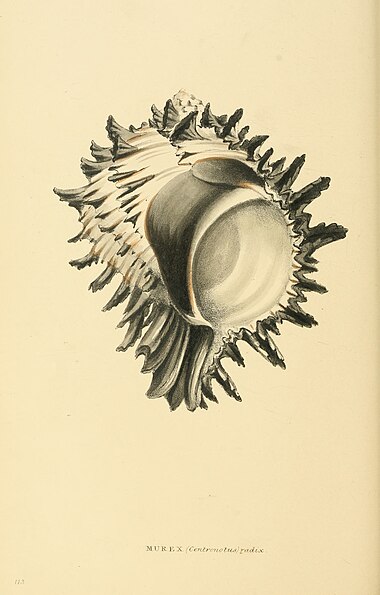Zoological Illustrations Series II/Plate 113
MUREX (Centronotus) radix.
MUREX (Centronotus) radix,
Porcupine Murex.
Genus Murex. Sub-genus Centronotus. Nob.
Sub-Generic Character.
See pl. 100.
Specific Character.
Shell ovate globuse, transversely grooved; with numerous varices, armed with compressed, spine-like foliations: colour white; the spines, base, and inner lip black.
Murex radix. Gm. 3527. Lam. Syst. 7. 168.
Centronotus radix was formerly a shell of excessive rarity, but many specimens have latterly been brought from Panama; one of these, obligingly lent to us by Mr. Cummin, we have here figured of the natural size.
We cannot too often place before the student those objects in nature which seem more especially to illustrate that wonderful system on which the whole has been created. In the infinite diversity which pervades the works of "Him who made us," two things have obviously been intended: one, the manifestation of His power in the creation of the individual: the other, an illustration of some important truth connected with the spiritual welfare of mankind. The first is manifest, and speaks to our senses: the second is emblematical, and calls for an exertion of those reasoning faculties with which the Creator, for such purposes, aided by those helps he has promised, has given to us. In accordance with this latter assumption, both divines and Naturalists concur in considering Nature as a book of Emblems, "where one thing represents another." That this theory, resting heretofore on general belief, is capable of mathematic definition, we have elsewhere largely demonstrated, (North. Zool.). And if, as regards one division of animated nature the theory is correct, it follows that it will be equally manifested in all other portions of the animal world, when they are sufficiently investigated. Hence it is that remote resemblances between objects, widely different in themselves, can be explained: hence the analogy which the Glires bears to the Hedgehogs, and to the Ceblepyrinæ; and hence the resemblance between this shell and the Porcupines; an analogy the more singular, as it extends even to the black and white colour of the spines.
